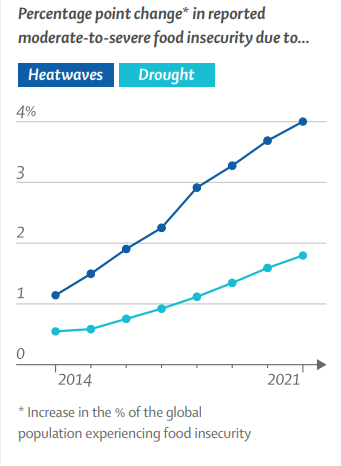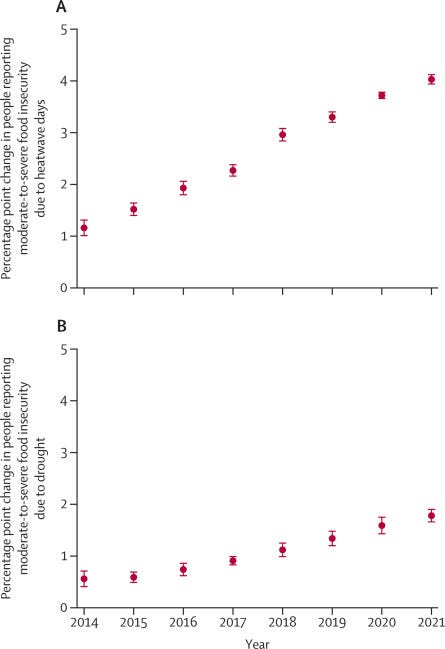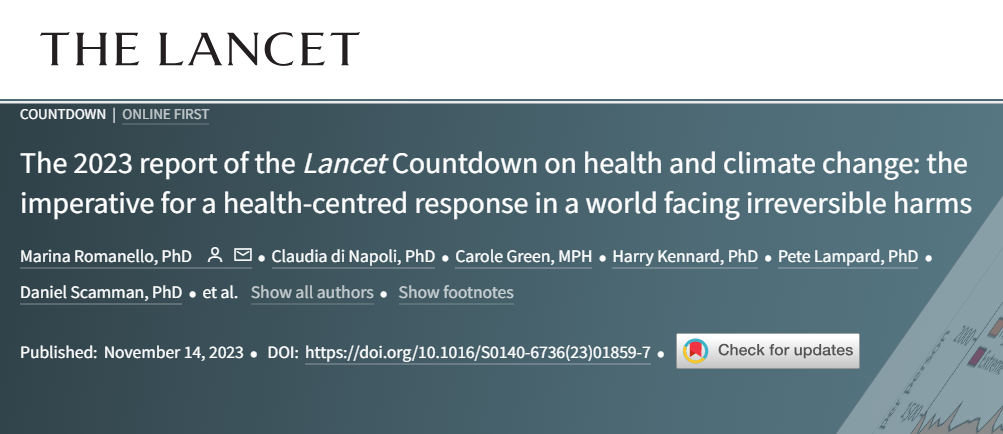the health strategist
platform
the most compreehensive knowledge portal
for continuous health transformation
and digital health- for all
Joaquim Cardoso MSc.
Chief Research and Strategy Officer (CRSO),
Chief Editor and Senior Advisor
December 1, 2023

- Higher frequency of heatwaves and droughts in 2021 was associated with 127 million more people experiencing moderate or severe food insecurity compared with 1981–2010
Deep Dive
Figure 4: Change in (A) the share of the population (percentage point change) reporting moderate-to-severe food insecurity (as defined by the Food Insecurity Experience Scale) due to heatwave days and (B) the frequency of drought months during the four major crop (maize, rice, sorghum, and wheat) growing seasons from 2014 to 2021

Indicator 1.4: food security and undernutrition — headline finding:
the higher frequency of heatwave days and drought months in 2021 compared with 1981–2010 is associated with 127 million more people experiencing moderate or severe food insecurity
In 2018–22, people experienced, on average, 86 days of health-threatening high temperatures annually.
60% of these temperatures were made more than twice as likely to occur by
- human-caused climate change Ageing populations,+
- an increasing incidence of noncommunicable diseases in many countries, and
- urbanisation are increasing populations’ vulnerability to extreme heat.
Globally, 735 million people faced hunger in 2022 and 3·1 billion people (42%) were unable to afford a healthy diet in 2021.
Through multiple and interconnected pathways, climate change is exacerbating food insecurity:
- by undermining crop yields;
- affecting the labour capacity of agricultural workers;
- and threatening the food security of populations dependent on marine resources through coastal sea surface temperature elevation, reduced ocean oxygenation, ocean acidification, and coral reef bleaching; disrupting supply chains; and reducing food access.
Minoritised communities, including Indigenous peoples and subsistence farmers, are particularly affected, as their access to primary and traditional food sources can be compromised, resulting in poorer health outcomes.
Globally, 735 million people faced hunger in 2022 and 3·1 billion people (42%) were unable to afford a healthy diet in 2021.
Increased food insecurity can also contribute to malnutrition, which can have irreversible negative effects on child health and development.
The first part of this indicator combines data from the Food and Agriculture Organization Food Insecurity Experience Scale (FIES) from 122 countries (up from 103 countries in the 2022 report of the Lancet Countdown) with the frequency of heatwave days and drought months (with the 12-monthly standardised precipitation evapotranspiration index) during the growth seasons of maize, rice, sorghum, and wheat, using a time-varying panel regression.
Compared with 1981–2010, a higher number of heatwave days was associated with 4·03 percentage points higher moderate or severe food insecurity (as defined by FIES) in 2021, whereas increasing drought frequency resulted in food insecurity being 1·78 percentage-points higher, equivalent to approximately 127 million more people experiencing food insecurity (figure 4).
Under a scenario compatible with limiting temperature rise to 2°C, 524·9 million additional people are projected to experience food insecurity by 2041–60 compared with the 1995–2014 baseline.
The global health co-benefits of a scenario compatible with 2°C of heating compared with 3·6°C of heating are projected to include 530 million fewer people experiencing food insecurity by 2041–60, and 1·1 billion fewer people by 2081–2100.
Marine food yields are threatened by sea surface temperature elevation through ocean acidification, coral reef bleaching, reduced oxygenation, and reduced primary productivity.
An increase in sea surface temperature (SST) is threatening marine food productivity and the livelihoods of many coastal populations.
The second part of this indicator monitors changes in SST — this year with improved geographical and temporal coverage.
The SST in global coastal areas increased by 0·51°C in 2020–22 compared with 1981–2010.
SST is projected to increase by 0·99°C by mid-century and by 1·23°C by the end of the century in a scenario compatible with limiting global mean atmospheric heating to 2°C.
SSTs are projected to rise even further under a scenario in which no further mitigation occurs, reaching 1·15°C by mid-century and 2·64°C by the end of the century.

Source: The Lancet [excerpt]
November 14, 2023
The 2023 report of the Lancet Countdown on health and climate change: the imperative for a health-centred response in a world facing irreversible harms
Marina Romanello, Claudia di Napoli, Carole Green, Harry Kennard, Pete Lampard, Daniel Scamman, Maria Walawender, Zakari Ali, Nadia Ameli, Sonja Ayeb-Karlsson, Paul J Beggs, Kristine Belesova, Lea Berrang Ford, Kathryn Bowen, Wenjia Cai, Max Callaghan, Diarmid Campbell-Lendrum, Jonathan Chambers, Troy J Cross, Kim R van Daalen, Carole Dalin, Niheer Dasandi, Shouro Dasgupta, Michael Davies, Paula Dominguez-Salas, Robert Dubrow, Kristie L Ebi, Matthew Eckelman, Paul Ekins, Chris Freyberg, Olga Gasparyan, Georgiana Gordon-Strachan, Hilary Graham, Samuel H Gunther, Ian Hamilton, Yun Hang, Risto Hänninen, Stella Hartinger, Kehan He, Julian Heidecke, Jeremy J Hess, Shih-Che Hsu, Louis Jamart, Slava Jankin, Ollie Jay, Ilan Kelman, Gregor Kiesewetter, Patrick Kinney, Dominic Kniveton, Rostislav Kouznetsov, Francesca Larosa, Jason K W Lee, Bruno Lemke, Yang Liu, Zhao Liu, Melissa Lott, Martín Lotto Batista, Rachel Lowe, Maquins Odhiambo Sewe, Jaime Martinez-Urtaza, Mark Maslin, Lucy McAllister, Celia McMichael, Zhifu Mi, James Milner, Kelton Minor, Jan C Minx, Nahid Mohajeri, Natalie C Momen, Maziar Moradi-Lakeh, Karyn Morrissey, Simon Munzert, Kris A Murray, Tara Neville, Maria Nilsson, Nick Obradovich, Megan B O’Hare, Camile Oliveira, Tadj Oreszczyn, Matthias Otto, Fereidoon Owfi, Olivia Pearman, Frank Pega, Andrew Pershing, Mahnaz Rabbaniha, Jamie Rickman, Elizabeth J Z Robinson, Joacim Rocklöv, Renee N Salas, Jan C Semenza, Jodi D Sherman, Joy Shumake-Guillemot, Grant Silbert, Mikhail Sofiev, Marco Springmann, Jennifer D Stowell, Meisam Tabatabaei, Jonathon Taylor, Ross Thompson, Cathryn Tonne, Marina Treskova, Joaquin A Trinanes, Fabian Wagner, Laura Warnecke, Hannah Whitcombe, Matthew Winning, Arthur Wyns, Marisol Yglesias-González, Shihui Zhang, Ying Zhang, Qiao Zhu, Peng Gong*, Hugh Montgomery*, Anthony Costello*
Key findings of the 2023 report of the Lancet Countdown on health and climate change
Alarming new projections reveal soaring health risks of persistent global inaction over the climate emergency.
The health threats experienced to date are an early symptom of the dangers our future might hold. Despite continued warnings of the risks, and regardless of agreed targets to limit temperature rise, the world is accelerating in the wrong direction.
However, for all the negatives, there are still positive signals of progress, and opportunities to deliver a healthy, thriving future for people all around the world. Building upon the progress already made, the Commission makes recommendations to maximise the benefits of climate change action for people’s health and wellbeing.
Explore the key findings and recommendations of the 2023 report of the Lancet Countdown on health and climate change in the infographic below, or read the full report for more details.
Infographic
https://www.thelancet.com/infographics-do/climate-countdown-2023












